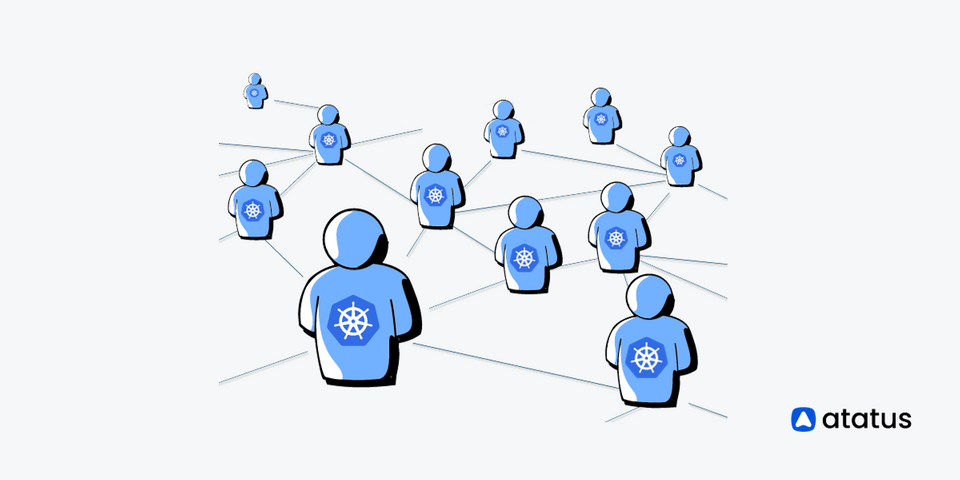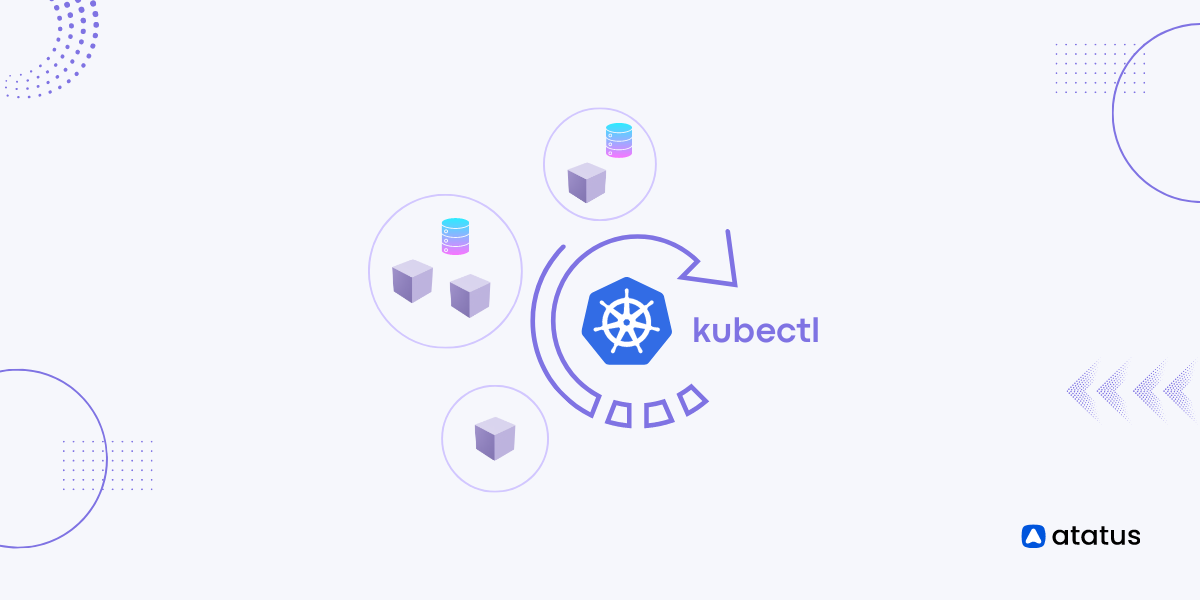Kubernetes Networking: Understanding Services and Ingress
Within the dynamic landscape of container orchestration, Kubernetes stands as a transformative force, reshaping the landscape of deploying and managing containerized applications.
At the core of Kubernetes' capabilities lies its sophisticated networking model, a resilient framework that facilitates seamless communication between microservices and orchestrates external access to applications.
Among the foundational elements shaping this networking landscape are Kubernetes Services and Ingress. Kubernetes Services serve as the linchpin within a cluster, offering a logical abstraction for communication between diverse elements of an application.
From the straightforward ClusterIP for internal communication to the versatile NodePort and LoadBalancer for external access, Services play a pivotal role in fostering connectivity within the Kubernetes ecosystem.
Concurrently, Kubernetes Ingress emerges as the gateway to external traffic, presenting a sophisticated mechanism for HTTP and HTTPS routing. With its Ingress controllers and resource configurations, Ingress shapes the external-facing aspect of applications, providing a potent toolkit for managing the egress and ingress of data.
In this blog, we embark on an enlightening journey to unveil the intricacies of Kubernetes networking, delving deeply into the functionalities and subtleties of Services and Ingress.
- What are Kubernetes Services?
- Types of Kubernetes Services with Examples
- What is Kubernetes Ingress?
- Key Components of Kubernetes Ingress
- Exploring Additional Kubernetes Networking Features
What are Kubernetes Services?
In the Kubernetes ecosystem, a Service stands as an abstraction designed to articulate a coherent set of Pods along with a defined policy for accessing them. This abstraction is instrumental in enabling communication between various components of an application, irrespective of the specific node on which they are deployed within the cluster. Services furnish a reliable endpoint that obscures the intricate details of individual Pod instances.
Key attributes and components characterising a Kubernetes Service include:
1. Pod Selection
Services employ a label-based selector to choose Pods. When creating a Service, a selector is specified to determine the Pods that the Service should target.
2. Stable IP and DNS Name
Each Service is allocated a stable IP address within the cluster (ClusterIP), ensuring persistence even during scaling operations. Additionally, an automatic DNS name is generated based on the Service name, simplifying discovery and connectivity for other parts of the application.
3. Service Types
Kubernetes accommodates diverse Service types tailored for specific use cases:
- ClusterIP: Exposes the Service on an internal cluster IP, suitable for intra-cluster communication.
- NodePort: Provides external access by exposing the Service on each Node's IP at a fixed port.
- LoadBalancer: Creates an external load balancer in the cloud provider's network for external access, commonly used in cloud environments.
- ExternalName: Establishes a mapping between the Service and an external domain name.
4. Ports and Endpoints
Services are associated with designated ports through which they receive traffic. The Service efficiently directs this traffic to the selected Pods based on their labels.
5. Service Discovery
Facilitating service discovery within the Kubernetes cluster is a pivotal role of Services. Components within the cluster seamlessly discover and connect to services using the designated Service name.
Types of Kubernetes Services with Examples
1. ClusterIP
In Kubernetes, a ClusterIP is a service type that exposes a service on an internal IP address within the cluster. This type of service is specifically designed for communication within the Kubernetes cluster and is not accessible externally. ClusterIP services provide a reliable and unchanging virtual IP address, serving as a stable entry point for interactions between different components, or pods, of the same application.
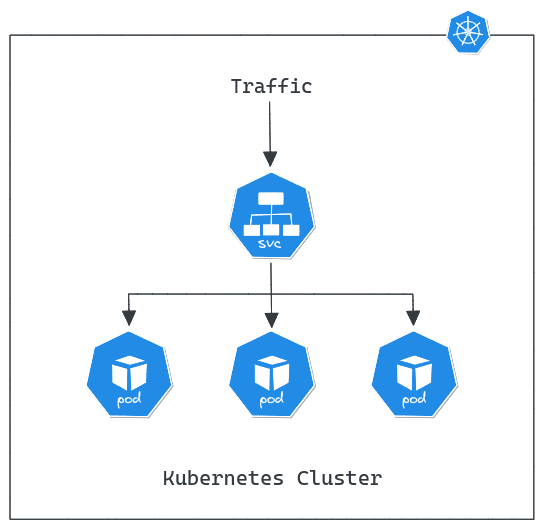
Key characteristics of ClusterIP services include:
- Internal Communication:
ClusterIP services are primarily utilized for facilitating communication among various components or pods within the same Kubernetes cluster. They establish a consistent and dependable endpoint for intra-cluster interactions.
- Stable IP Address:
Each ClusterIP service is assigned an unchanging internal IP address within the cluster. This IP remains constant even if the number of underlying pods is dynamically adjusted, ensuring a persistent access point.
- Service Discovery:
Components within the cluster can discover and establish connections with services using the associated ClusterIP. The service name, linked to the ClusterIP, is employed for DNS resolution within the cluster.
Example YAML Configuration:
apiVersion: v1
kind: Service
metadata:
name: my-clusterip-service
spec:
selector:
app: my-app
ports:
- protocol: TCP
port: 80
targetPort: 8080In this example, the ClusterIP service named `my-clusterip-service` directs traffic to pods labelled with `app: my-app` on port 8080.
- Limited External Access:
ClusterIP services are not designed for external accessibility. Their purpose is to facilitate communication exclusively within the bounds of the Kubernetes cluster.
ClusterIP services play a pivotal role in promoting efficient and scalable communication among microservices within the Kubernetes environment. They contribute to the abstraction layer that simplifies service discovery and fosters communication in the context of a distributed application architecture.
2. NodePort
In Kubernetes, a NodePort is a service type that exposes a service on each Node's IP at a designated static port. This service type is designed to facilitate external access to a service from outside the Kubernetes cluster. NodePort services provide a straightforward mechanism for making a service accessible externally by mapping a specific port on every node to the service.
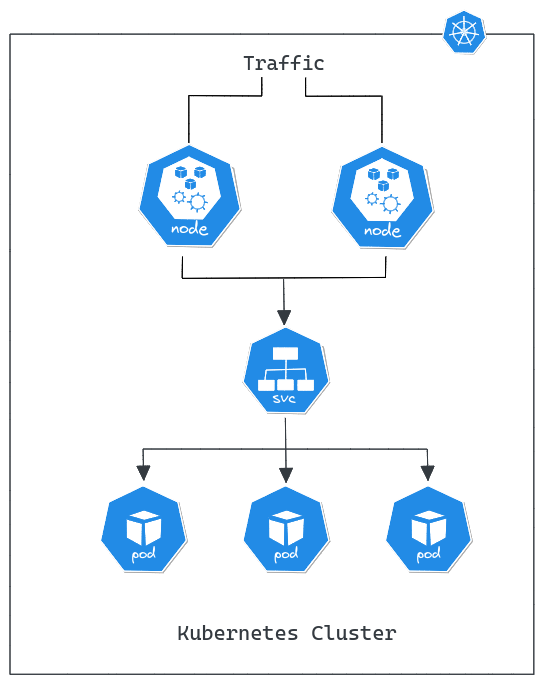
Key characteristics of NodePort services include:
- External Accessibility:
NodePort services enable external access to the service by exposing it on a consistent port across all nodes in the cluster. External clients can reach the service using the IP address of any cluster node along with the assigned NodePort.
- Static Port Assignment:
Each node is assigned a static port through which the service is accessed. This port remains constant, providing a dependable entry point for external communication.
Example YAML Configuration:
apiVersion: v1
kind: Service
metadata:
name: my-nodeport-service
spec:
selector:
app: my-app
ports:
- protocol: TCP
port: 80
targetPort: 8080
type: NodePortIn this example, the NodePort service named `my-nodeport-service` exposes the application on a specific port on each node, allowing external access.
- Accessibility via Node's IP:
External clients can connect to the service using the IP address of any cluster node along with the designated NodePort. For instance, if a node has an IP address of `NodeIP` and the NodePort is set to `32000`, the service can be reached at `NodeIP:32000`.
- Limited External Access Control:
While NodePort services facilitate external access, they may lack granular control over external traffic. For more advanced traffic management, supplementary tools such as Network Policies or Ingress can be employed.
NodePort services are frequently used when there is a requirement to expose a service to external clients, particularly in development or testing scenarios. This service type offers a direct and uncomplicated means of making services externally accessible from beyond the Kubernetes cluster.
3. LoadBalancer
In Kubernetes, a LoadBalancer is a service type designed to create an external load balancer within the cloud provider's network. This service facilitates external access to the application, especially in cloud environments. By automatically provisioning an external load balancer, LoadBalancer services distribute incoming traffic across multiple nodes hosting the service, ensuring both high availability and scalability.
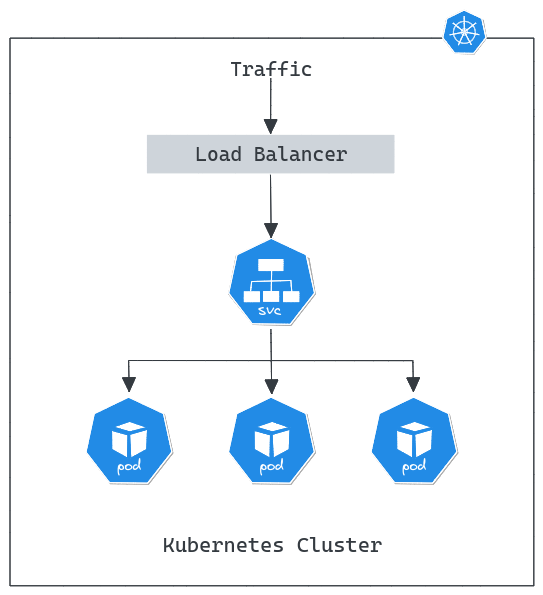
Key features of LoadBalancer services include:
- External Accessibility:
LoadBalancer services enable external access to the application by establishing an external load balancer in the cloud provider's infrastructure. This load balancer efficiently distributes incoming traffic among the nodes running the service.
- Dynamic IP Assignment:
The external load balancer is dynamically assigned an IP address by the cloud provider. Clients can connect to the service using this dynamically assigned IP.
Example YAML Configuration:
apiVersion: v1
kind: Service
metadata:
name: my-loadbalancer-service
spec:
selector:
app: my-app
ports:
- protocol: TCP
port: 80
targetPort: 8080
type: LoadBalancer
In this illustration, the LoadBalancer service named `my-loadbalancer-service` sets up an external load balancer to facilitate external traffic reaching the application.
- Cloud Provider Integration:
LoadBalancer services seamlessly integrate with the load-balancing capabilities provided by the respective cloud infrastructure, utilizing the native solutions offered by the cloud provider.
- Automatic Scaling:
The external load balancer scales dynamically with the number of nodes hosting the service. This ensures efficient traffic distribution and optimal resource utilization.
- Cost Considerations:
Users should be aware that utilizing LoadBalancer services may incur additional costs, as cloud providers often charge fees associated with external load balancers. It's important to consider the cost implications based on the pricing model of the chosen cloud provider.
LoadBalancer services prove invaluable when applications require access from external networks, streamlining the process of exposing services while enhancing reliability and effectively managing incoming traffic for applications deployed in cloud environments.
4. ExternalName
In Kubernetes, an ExternalName is a service type designed to link a service to an external domain name. Unlike other service types focused on exposing internal services within the cluster, ExternalName serves a specific purpose when the objective is to associate a service with an external entity located outside the Kubernetes environment.
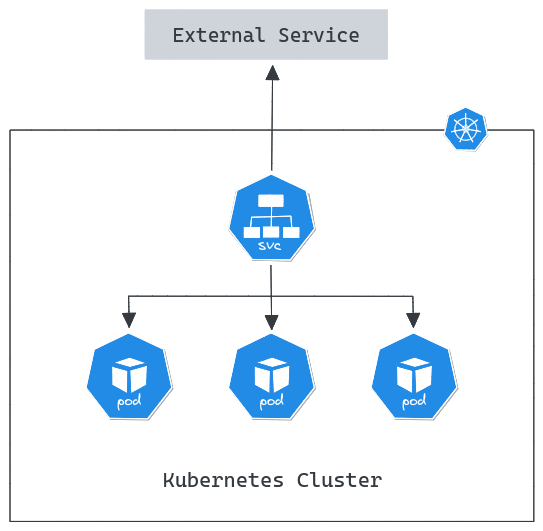
Key attributes of ExternalName services include:
- External Domain Mapping:
ExternalName services facilitate the mapping of a service to an external domain name, enabling smooth integration with services situated beyond the confines of the Kubernetes cluster.
- Use Case:
This service type proves valuable when the intention is to reference an external service using a Kubernetes service name. This abstraction shields applications within the cluster from dealing with specific external details.
Example YAML Configuration:
apiVersion: v1
kind: Service
metadata:
name: my-externalname-service
spec:
type: ExternalName
externalName: my-external-service.example.comIn this illustration, the ExternalName service named `my-externalname-service` is linked to the external domain `my-external-service.example.com`.
- No Cluster IP:
ExternalName services do not possess a Cluster IP since their role is to reference external services without exposing them within the cluster.
- Service Discovery:
Components within the Kubernetes cluster can utilize the service name for discovery and reference, relying on DNS resolution to establish connections with the external service.
- Limited Use Cases:
ExternalName services are typically employed in specific scenarios where direct integration with external services is necessary, while still maintaining a level of abstraction within the Kubernetes environment.
ExternalName services serve as a conduit between internal Kubernetes services and external entities, offering a standardized naming convention for referencing external services within the cluster. They are crucial in ensuring consistency and simplicity in communication between services, even when interacting with resources external to the Kubernetes environment.
What is Kubernetes Ingress?
In Kubernetes, an Ingress serves as an API object designed to facilitate HTTP and HTTPS routing for external traffic to services within the cluster. It acts as the entry point, allowing users to define rules for directing incoming traffic based on various criteria. Ingress is a valuable tool for managing external access to services, offering advanced routing, load balancing, and SSL/TLS termination capabilities.
Kubernetes Ingress provides a robust and adaptable solution for managing external access to services, empowering users to define intricate routing rules and efficiently handle traffic. The role of Ingress controllers is pivotal in translating these rules into actionable configurations, ensuring the seamless flow of external traffic to the designated services.
Key Components of Kubernetes Ingress
The essential components of a Kubernetes Ingress encompass:
1. Ingress Resource
The Ingress resource is a Kubernetes API object that outlines the rules governing the routing of external traffic to services within the cluster. It delineates hostnames, paths, and associated backend services for different routes.
Example:
apiVersion: networking.k8s.io/v1
kind: Ingress
metadata:
name: my-ingress
spec:
rules:
- host: myapp.example.com
http:
paths:
- path: /app
pathType: Prefix
backend:
service:
name: my-app-service
port:
number: 802. Ingress Controller
The Ingress controller serves as a pivotal component responsible for interpreting the rules defined in the Ingress resource. It actively monitors changes in Ingress resources and configures the underlying load balancer or reverse proxy accordingly.
3. Backend Service
The backend service is the Kubernetes Service to which incoming traffic is directed based on the rules specified in the Ingress. It represents the application or service designated to handle incoming requests.
4. Rules
Rules within the Ingress stipulate the conditions for routing traffic, encompassing factors like hostnames and paths. Each rule articulates a set of criteria and the corresponding backend service.
Example:
spec:
rules:
- host: myapp.example.com
http:
paths:
- path: /app
pathType: Prefix
backend:
service:
name: my-app-service
port:
number: 805. TLS/SSL Configuration
Ingress supports TLS/SSL termination, permitting users to configure secure communication with services. TLS certificates can be linked to Ingress objects to enable encrypted connections.
Example:
spec:
tls:
- hosts:
- myapp.example.com
secretName: my-tls-secret6. Annotations
Annotations are optional metadata that can be appended to the Ingress resource, providing additional configuration details or instructions to the Ingress controller.
Example:
metadata:
annotations:
nginx.ingress.kubernetes.io/rewrite-target: /
These components collaboratively define, manage, and execute routing rules for external traffic in a Kubernetes cluster. The Ingress controller vigilantly observes alterations in Ingress resources, ensuring the application of specified rules to the underlying infrastructure and facilitating flexible and dynamic management of external access to services.
Exploring Additional Kubernetes Networking Features
Kubernetes extends its networking capabilities beyond fundamental services and ingress, offering a suite of advanced features that enhance flexibility, security, and performance for containerized applications.
Exploring these additional networking features reveals a nuanced and customizable approach to managing communication within the Kubernetes cluster:
1. Network Policies
Network Policies empower users to define rules governing pod-to-pod communication, enabling precise control over which pods can communicate and on which ports. This feature is instrumental for enforcing security measures within the cluster.
Use Case: Establishing communication restrictions and access controls to enhance security for different components of an application.
2. Pod-to-Pod Communication
Pods within the same Kubernetes cluster can seamlessly communicate with each other through the cluster's internal network, utilizing their assigned IP addresses.
Use Case: Facilitating communication between microservices or application components residing within the cluster.
Kubernetes incorporates DNS-based service discovery, assigning a DNS name to each service. This facilitates easy service discovery within the cluster, allowing pods to communicate using DNS names.
Use Case: Simplifying communication between pods and services through standardized DNS names.
3. CNI (Container Network Interface)
CNI serves as a specification and library set for network plugins in container orchestration platforms. Kubernetes utilizes CNI to integrate diverse networking solutions, providing flexibility in choosing and implementing pod networking.
Use Case: Integrating various networking solutions, such as Calico, Flannel, or Weave, based on specific requirements.
4. IPv6 Support
Kubernetes supports IPv6 for pod networking, allowing pods to be assigned IPv6 addresses alongside or instead of IPv4 addresses.
Use Case: Embracing IPv6 in environments where it is the preferred or required networking protocol.
5. Custom Network Plugins
Kubernetes allows the integration of custom network plugins through the CNI interface, facilitating the implementation of specialized networking solutions tailored to unique use cases.
Use Case: Incorporating custom networking features or integrating with third-party solutions to meet specific requirements.
6. EndpointSlices
EndpointSlices provide a scalable representation of endpoints associated with a service, enhancing the performance of services with a large number of endpoints.
Use Case: Improving scalability for services handling numerous endpoints.
7. Multus CNI
Multus is a CNI plugin enabling the attachment of multiple network interfaces to a pod, allowing for multiple network connections and IPs simultaneously.
Use Case: Supporting scenarios where pods require connections to multiple networks or segments concurrently.
8. KubeProxy Modes
KubeProxy, responsible for load balancing service traffic, offers various modes of operation such as userspace, iptables, and IPVS, each with distinct advantages and trade-offs.
Use Case: Selecting the appropriate KubeProxy mode based on specific network requirements and infrastructure characteristics.
9. eBPF (extended Berkeley Packet Filter)
eBPF technology enables the execution of custom programs in the Linux kernel without modifying its source code. In Kubernetes, eBPF can be employed for advanced network monitoring, security policies, and performance optimizations.
Use Case: Implementing sophisticated network monitoring, security measures, or performance enhancements using eBPF programs.
These supplementary networking features empower Kubernetes users to tailor and optimize communication, security, and performance within their clusters, providing a rich toolkit for managing diverse networking scenarios and requirements.
Conclusion
In summary, our exploration of Kubernetes networking has provided valuable insights into the essential components of Services and Ingress. Grasping the intricacies of these foundational elements is crucial for orchestrating seamless communication and access within a Kubernetes cluster.
Services serve as the linchpin, facilitating smooth internal pod communication and enabling the exposure of applications to external entities. Their adaptability, showcased through ClusterIP, NodePort, and LoadBalancer types, caters to a range of networking requirements, ensuring robust connectivity.
Complementing Services, Ingress serves as the gateway for external traffic, introducing advanced routing and control mechanisms. By defining rules for HTTP and HTTPS traffic, Ingress empowers users to shape request flows, manage load balancing, and implement SSL termination, thereby enhancing the accessibility and security of applications.
As we navigate the intricate realm of Kubernetes networking, a comprehensive grasp of Services and Ingress proves pivotal. These components not only streamline communication within the cluster but also lay the groundwork for orchestrating resilient, scalable, and secure applications. Armed with this knowledge, Kubernetes practitioners can navigate networking nuances, optimizing their deployments for peak performance and reliability.
Atatus Kubernetes Monitoring
With Atatus Kubernetes Monitoring, users can gain valuable insights into the health and performance of their Kubernetes clusters and the applications running on them. The platform collects and analyzes metrics, logs, and traces from Kubernetes environments, allowing users to detect issues, troubleshoot problems, and optimize application performance.
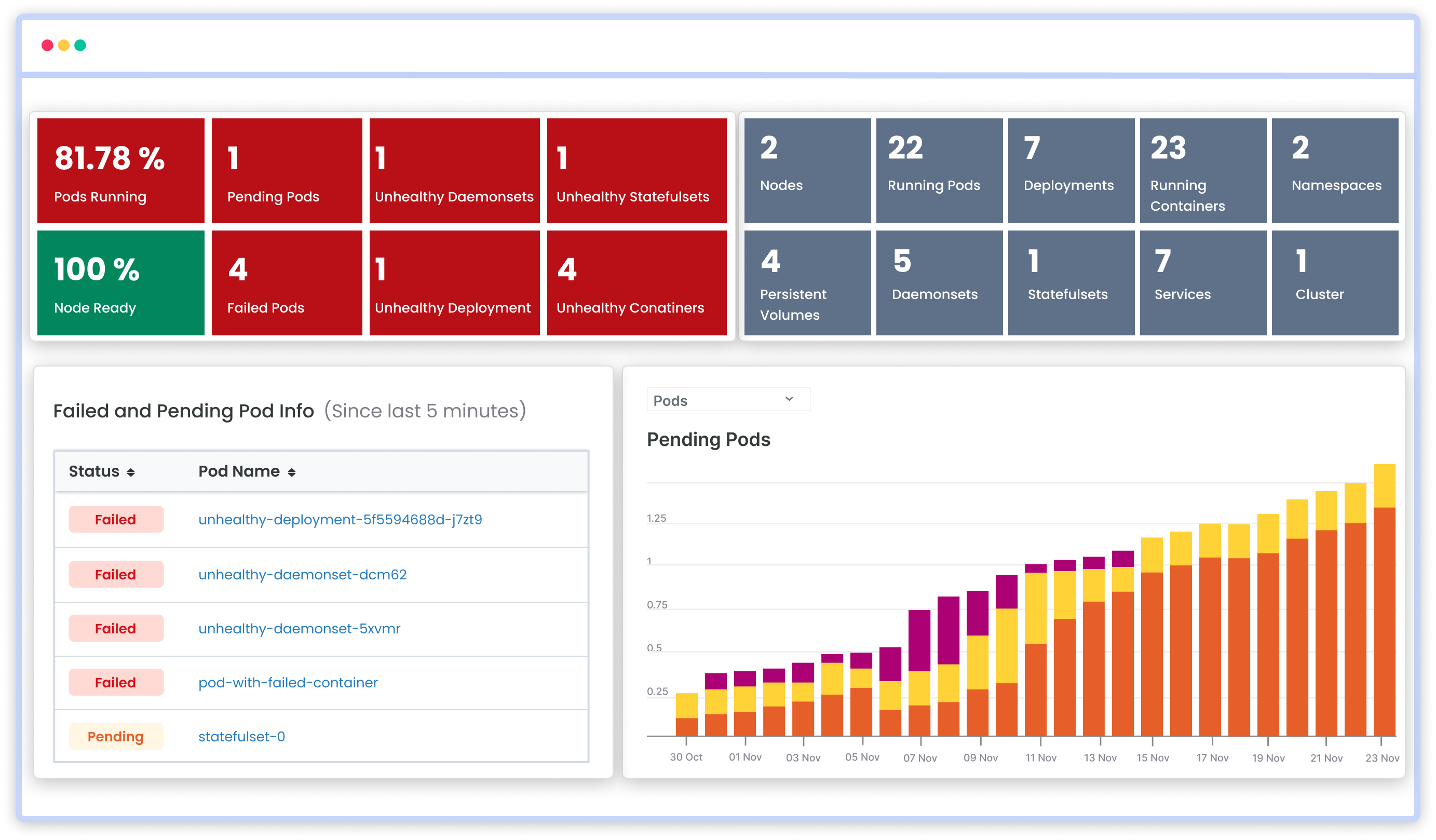
You can easily track the performance of individual Kubernetes containers and pods. This granular level of monitoring helps to pinpoint resource-heavy containers or problematic pods affecting the overall cluster performance.
#1 Solution for Logs, Traces & Metrics
APM
Kubernetes
Logs
Synthetics
RUM
Serverless
Security
More

